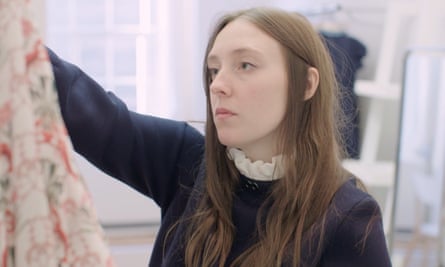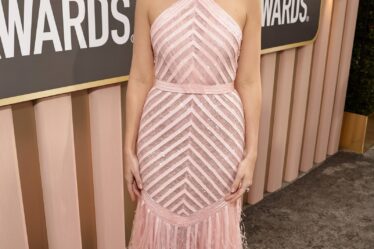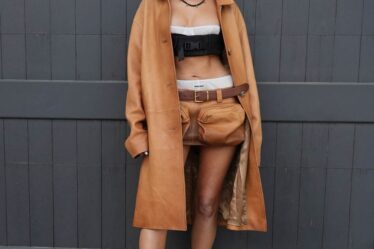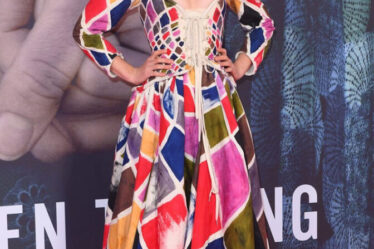
It is not every luxury fashion designer who invites the Uruguayan sheep farmer who supplies the wool for their collection to their east London studio to see the finished product. But Amy Powney is not every luxury fashion designer – and a new film charting her 18-month journey to make a fully sustainable collection shows that in spades.
Fashion Reimagined follows Powney, the owner and creative director of hip British label Mother of Pearl, as she tries to create garments that – bear with me – are organic, traceable, socially responsible and considerate of animal welfare; produced in the smallest geographic region possible; and using minimal water and chemicals as well as being nice to wear. Spoiler alert: it is not easy.
As the film explains, a normal cotton shirt will have gone through roughly eight steps before being shipped to the customer, many of them involving harmful chemicals, and the average garment will travel to five different countries. “I hope people watch and see how complicated it is,” she tells me over a video call this week, “but that you can do it – you just have to put hard work in.”
She and then Mother of Pearl product designer Chloe Marks start the journey with more questions than answers. Among them: “What is a sustainable fabric?” and words to the effect of: “Please can we come and meet your sheep?”
So begins a lengthy piece of detective work to unpick complex and convoluted supply chains and find wool, cotton and the people growing and processing them in ways that meet their strict criteria. They travel from Uruguay to Peru to Austria to Turkey. They have unexpected items on their to do list – “1) Order 20 metres of fabric. 2) Check Isis affiliation of Turkish cotton. 3) Need some more zips” – and plenty of setbacks. It makes for surprisingly compelling viewing.
The reasons a more ethical industry is an urgent necessity are, on the whole, well known. But it doesn’t hurt that the film reminds us. Peppered throughout are statistics that highlight fashion’s impact on our planet: “If the fashion industry were a country, it would rank third for carbon emissions after China and the United States.” About how rampant overconsumption has become: “We buy three times as many clothes as we did in 1980. And wear them for half as long.” Plus the industry’s impacts on human beings: “Only 2% of the people who make our clothes earn a living wage.”
The world of sustainable fashion has come a long way since Mother of Pearl’s line No Frills debuted at London fashion week in 2018. It is now in the mainstream. Back then, Powney was an outlier. “If it’s not in the media or you don’t hear people talking about it, perhaps I seem a little mental,” she says at one point.
Having grown up off-grid in a caravan in Lancashire, she had felt like an outsider in fashion for years. It is when standing with sheep that she had an epiphany. “You see it in the film: I turn up in a field with farmers. This is how I grew up,” she tells me. “I grew up picking cabbage. This is who I am, and I suddenly thought: ‘I’m not going to run away from this any more. I’m going to celebrate it.’”
It takes people willing to flip processes on their head and find improved ways of doing the same old business of making clothes in an industry that, for all its creative verve, is often afraid of change.
You could be forgiven for questioning whether being a luxury fashion designer is the best vocation, and it’s something Powney wrangles with. But, she says, “we all have to wear clothes. We don’t have to have as many as we have, but fundamentally people have to be dressed. So in a way, would I rather you shopped from H&M or us? I’m going to say us because I am committed to doing the right thing.” Of course not everyone can afford her brand and the exclusivity of sustainable fashion is a hot topic – debates about fast fashion often get bogged down in classism and snobbery.
Powney cuts through a lot of the noise. She has an analogy: “My mum doesn’t know about fashion at all. She will just pick something up from the supermarket because she needs it. She probably owns one-fifth of the clothes that I own. Mine might be all from my brand and sustainable – but still, if you totted up the carbon footprint, she wins because she has less.” Referring to Vivienne Westwood’s adage “Buy better, buy less”, Powney says: “If you can’t buy better because you can’t afford it, you can still buy less … You can also buy vintage, secondhand – there’s so many different ways now.”
In the past four years, the number of clothes described as sustainable has quadrupled, we are told in the film. Yet fashion’s impact is getting worse. “There is lots of talk and no action,” says Powney. Brands are falling over themselves to label their clothes green, but what that actually means is often something as simple – and deceptive – as the fact that they have used organic cotton, which could still leave room for all kinds of exploitation of people and planet within the process. “You can’t buy a T-shirt for £2 from Primark and [think] that’s fine just because it’s organic cotton – it’s impossible,” says Powney.
This gets to the heart of the problem: what sustainable means is up for grabs. The truth is, as Powney puts it: “Nothing is sustainable.” These might be strange words for someone who is a leading voice in the sustainable fashion space, but she would know. “Everything that’s made has a footprint, so what does that even mean?” All products come at a cost. But some come at much greater cost than others.
The next best thing gets to a more honest assessment. “For me sustainability is a mindset,” she says. “The word is not tangible.” For Powney’s brand it means: “We’re using the best possible practices and we’re trying really hard, but the term sustainability you can only really connect to my intention – you can’t really connect it to the product.” This is what makes the trumpet blowing of so many brands around their green credentials so laughable. Powney has dedicated years to making her products as sustainable as they can be and would still tell you the ways in which they can never truly be sustainable.
How do we encourage others in the industry to become more genuine in their efforts to be sustainable? “I feel like I’ve got answers to everything, but I just don’t on that,” she says. “I’ve been trying, and I feel like this whole process of the film has been a wonderful experience – but the most frustrating part has been: why aren’t certain brands or institutions or retailers chomping at the bit and learning from this?”
There is hope, however. For evidence, “you can do simple equations,” Powney says. “Look at the press [in 2018] versus the press now. The pickup of that conversation five years ago was zero – and now it’s everywhere.”



